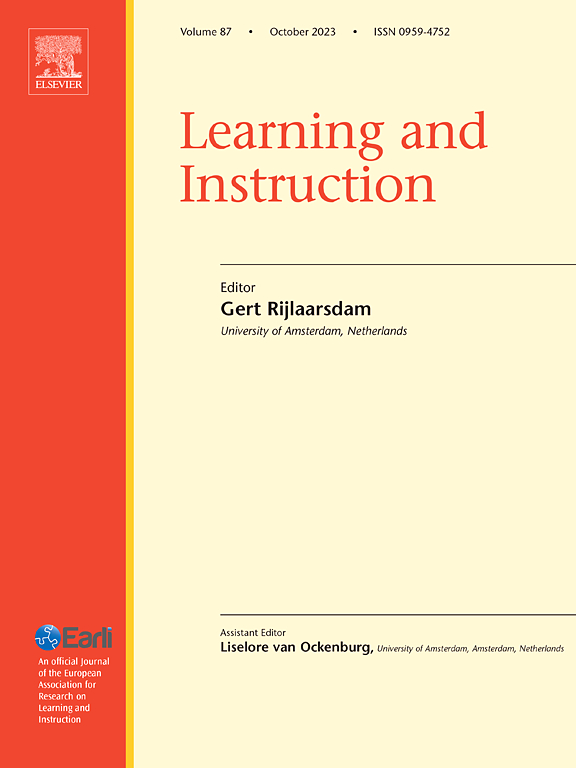策略重要:儿童类别学习策略运用的五年纵向研究
IF 4.9
1区 教育学
Q1 EDUCATION & EDUCATIONAL RESEARCH
引用次数: 0
摘要
背景策略在组织知识、促进区分和推广、提高认知效率等方面发挥着重要作用。虽然研究表明成人可以有效地使用各种分类策略来提高学习效果,但对儿童如何使用这些策略以及他们的发展能力使他们能够应用这些策略的程度的了解有限。目的研究小学生类别学习策略使用的年龄分布,探讨策略与一般认知能力之间的相互作用对学习成绩的影响。方法以5-4任务为实验工具,探讨儿童使用规则型策略和范例型策略的情况。我们通过工作记忆、处理速度和流体智力进行评估。在五年的时间里,每年从157名小学生中收集数据。研究人员还收集了155名大学生的数据。结果儿童更倾向于使用基于规则的策略,且策略选择不受g的影响。此外,在控制g的情况下,基于规则的策略和基于范例的策略对学习成绩都有显著的正向影响。范例策略甚至可以调节g对学习成绩的影响。这些发现增强了我们对儿童策略使用及其与g的相互作用如何影响学习行为的理解。他们还提出了通过在教学实践中培养策略来提高学习成果的实际方法。本文章由计算机程序翻译,如有差异,请以英文原文为准。
Strategy matters: A five-year longitudinal study of Children's strategy utilization in category learning
Background
Strategies play crucial roles in structuring knowledge, facilitating differentiation and generalization, and enhancing cognitive efficiency. While research indicates that adults can effectively use various classification strategies to improve learning outcomes, there is limited understanding of how children employ these strategies and the extent to which their developing abilities enable them to apply such strategies.
Aims
The purpose of this paper is to map age patterns of strategy utilization during category learning among elementary school children and to explore the interplay between strategies and general cognitive abilities (g) in affecting learning performance.
Methods
The 5-4 task served as the experimental tool to explore how children utilize rule-based or exemplar-based strategies. We assessed g by administering measures of working memory, processing speed, and fluid intelligence.
Samples
Data collection occurred annually over a five-year period from a sample of 157 elementary school children. Data on 155 university adults were also collected.
Results
Children tended to use rule-based strategies more than exemplar-based strategies, and their strategy choices were not influenced by g. Furthermore, both rule- and exemplar-based strategies demonstrated significantly positive effects on learning performance, even after controlling for g. While younger children performed better with rule-based strategies, older children showed superior performance with exemplar-based strategies. Exemplar strategies even moderated the effect of g on learning performance.
Implications
These findings enhance our understanding of how children's strategy use and its interaction with g influence learning behavior. They also suggest practical ways to enhance learning outcomes by cultivating strategies in instructional practices.
求助全文
通过发布文献求助,成功后即可免费获取论文全文。
去求助
来源期刊

Learning and Instruction
Multiple-
CiteScore
11.30
自引率
4.80%
发文量
109
期刊介绍:
As an international, multi-disciplinary, peer-refereed journal, Learning and Instruction provides a platform for the publication of the most advanced scientific research in the areas of learning, development, instruction and teaching. The journal welcomes original empirical investigations. The papers may represent a variety of theoretical perspectives and different methodological approaches. They may refer to any age level, from infants to adults and to a diversity of learning and instructional settings, from laboratory experiments to field studies. The major criteria in the review and the selection process concern the significance of the contribution to the area of learning and instruction, and the rigor of the study.
 求助内容:
求助内容: 应助结果提醒方式:
应助结果提醒方式:


